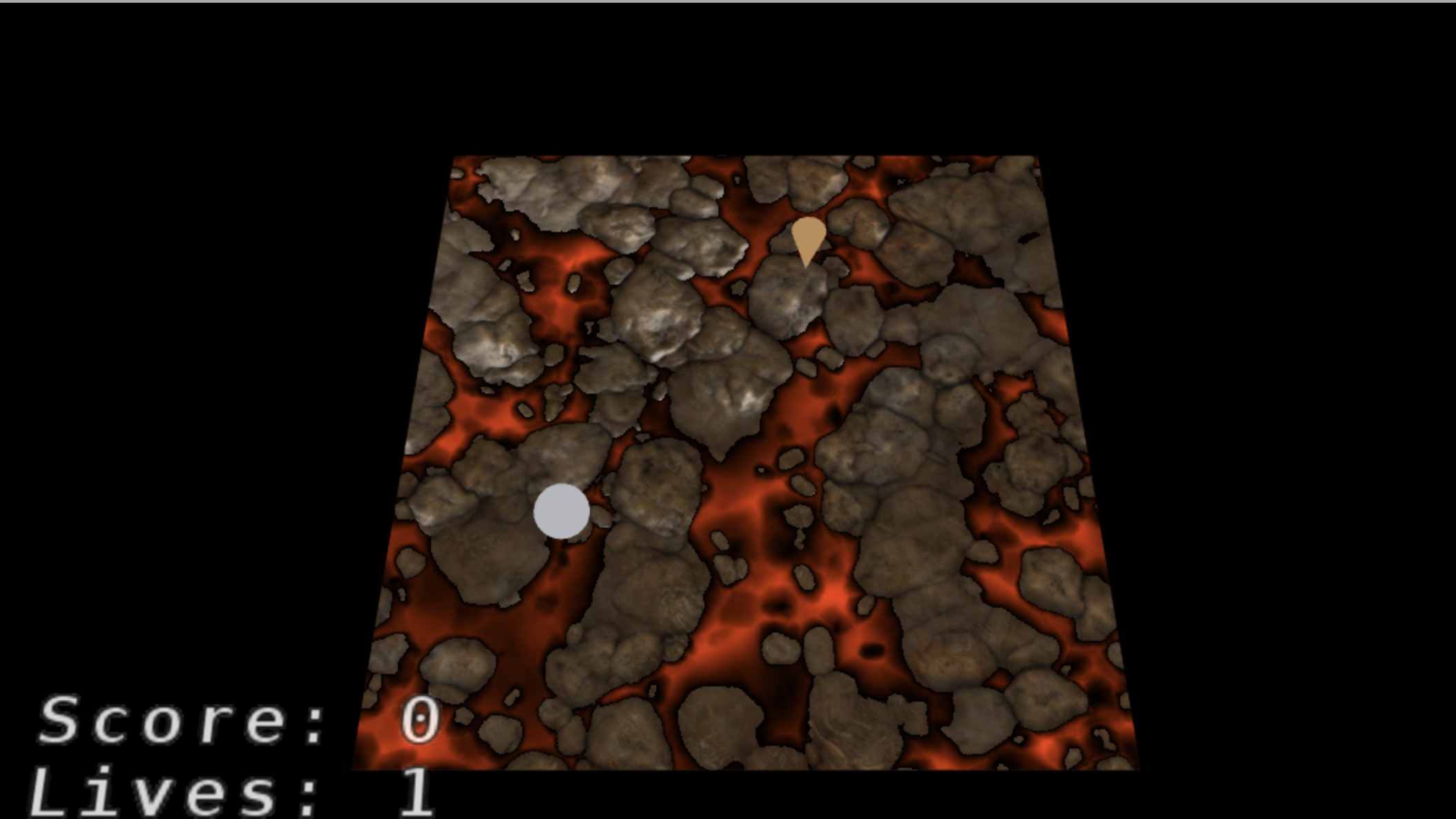Xiao Yang 305346127 Zhengyang Liu 105114114
The main inspiration of our project comes from various modern AAA titles, such as DOOM and Anthem, which employs many advanced technologies while shading the environment. Our project simulates a rough rock surface populated by hot, molten lava.
Unlike many of the previous final project submission, our project put a stronger emphasis on the underlying rendering technology. First, we can't have lava without the underlying rocky surface, therefore we first give a basic implementation of a textured, normal mapped phong shader for the rocks. The rock texture comes from a free source online.
Note that the specular value has been toned up to a rather unrealistic value - so that we can easily verify that the normal mapping is working as intended.
Lava, just like any liquid, behaves in such a way that it fills all the volume below a certain height. We take advantage of this liquid-specific property to implement a procedural way of spawning and rendering lava given just an extra height map. The technical detail is discussed in the Advanced Features section below.
Given the static lava rendering, additional experimental techniques are also used to animate the result. Firstly, the lava color is interpolated between bright orange and red, linearly with respect to time, giving a "burning" expression to the lava. We also experimented using flow maps to manipulate the uv coordinate per fragment, which is detailed below.
To showcase how our lava can be used as an asset in graphics works such as games and animations, we created a simple interactive game where the player has to pick up scoops of ice cream using a cone before they fall into the lava. Starting with 3 lives, a life is lost when a scoop of ice cream falls into the lava, and the game is over when the player has no more lives. Picking up a scoop of ice cream gives the player a point.
To check for collisions between the ice cream scoops, the cone, we simply checked the xyz coordinates of the objects for values within range. For collisions between the lava and the ice cream scoops, a straightforward y-value check is sufficient. We used 3 arrays to store the transformation matrices, the colors, and the falling speed of the ice cream scoops respectively, as they are chosen using Math.random() within a certain range. When a scoop either falls into the lava or is collected by the player, we remove the element in the 3 arrays at the index that represents that scoop.
This implementation is a simplified version implemented by the famous AAA multiplayer game Anthem, which is examined in great detail in a GDC 2019 talk.
We have 3 textures controlling different aspects of rendering. The albedo texture serves as a texture for diffuse color, normal texture stores the normal at each point, whereas the bump map stores the height of each point. Combined, the final rendered product will be a seemingly "rough" surface while the underlying primitive stays a flat plane. In our implementation, only the first channel of the height map is used - it is that "height" of a point directly above the "true position", the updated position is for calculating lighting model only.
If a fragment is found to be below a certain threshold (the "sea level" of the lava), then we immediately disregard the result from the phong lighting model. That is because we want the lava to be unlit. (Or emissive, if we have any sort of global illumination) The color of the lava is based only on the "depth" of lava at a point, the deeper the lava, the hotter the region is thus the more bright the lava appears to be. We linearly interpolate from black to a bright lava color, using the parameter which is height rescaled to [0,1].
The flow map serves as an experimental method to animate the lava flow. It is explained in detail in a GDC 2018 talk.
Back in assignment 2 of the course, we animate the texture coordinates by directly multiplying with a uniform rotation matrix. The idea of a flow map is, the transformation on the texture coordinates can be baked, or cached, into a texture, just like normal and height. The x channel of the flow map tells us how do we want to displace the u texture coordinate, while the y channel controls the v coordinate.
At each fragment and for each direction, the value between [0,1] is first normalized into [-0.5, 0.5], so that we can move both ways, we then multiply by flow speed and time to get desired displacement in that direction. The original texture coordinate is used once to get an updated uv-coordinate, which is used in downstream texture sampling of color, normal and height.
We could control the "flow" of the lava arbitrarily with the flow map.
Since we calculate height as distance directly above a fragment, only its x(or red) value is used. In the flow map, since it represents the speed vector of uv, only xy(rg) channels are used. We could potentially put height as the z(blue) channel in the flow map, thus reducing texture VRAM cost by 1/4 by reducing one texture. We did not do that because it is potentially confusing for the reader.
GDC 2019, Shading the World of Anthem (https://www.youtube.com/watch?v=IjQWRjWZGn0)
GDC 2018, Applying AAA Techniques on Mobile Games: Understanding Flow Maps and Its Applications (https://www.gdcvault.com/play/1025044/Applying-AAA-Techniques-on-Mobile)
Rock texture (https://3dtextures.me/2020/07/07/stylized-rocks-001/)
This project is based directly on the given architecture, no additional setup is required.





